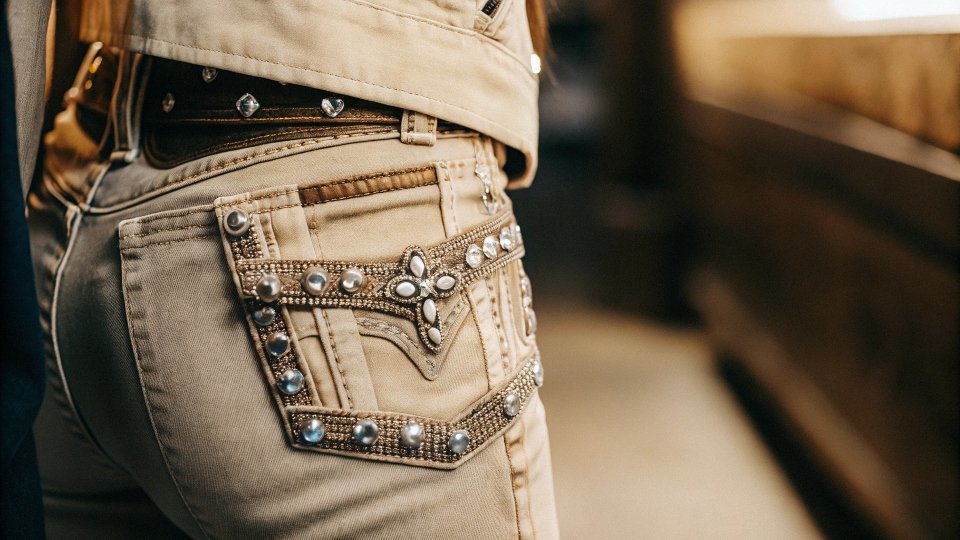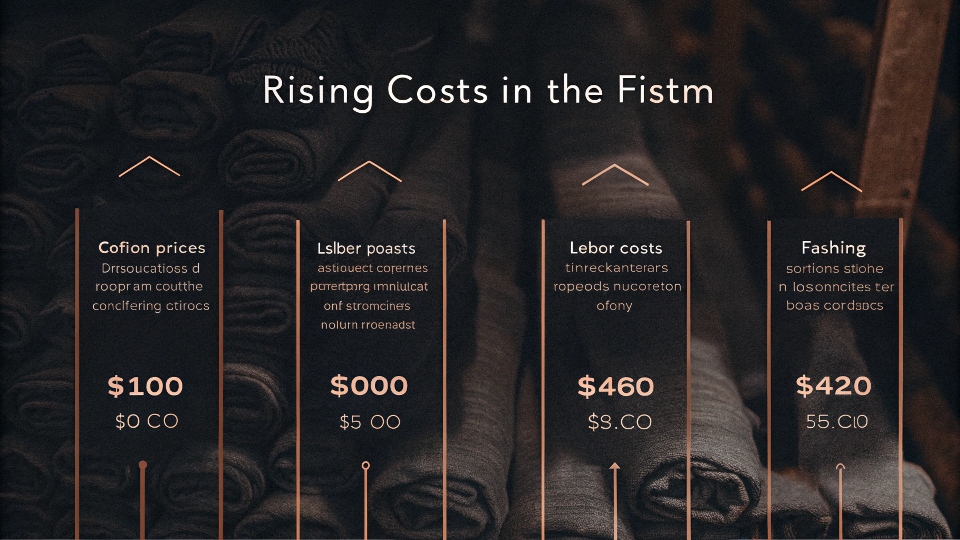You see a pair of Miss Me jeans, decorated with thick stitching1 and sparkling crystals, carrying a surprisingly high price tag. You assume all that flash is just a gimmick to justify the cost.
Miss Me jeans are expensive because their signature embellished designs2 require intense, specialized labor. The combination of thick stitching, hand-set crystals, and multi-layered pocket construction is far more time-consuming and costly to produce than a standard five-pocket jean.
As someone who runs a denim factory, I see two very different kinds of cost. There's the cost of a complex wash, like you'd find on Purple Brand jeans. And then there's the cost of complex embellishment.
This is the world of Miss Me. When a designer brings me a design with this level of decoration, my first thought isn't about the washing machines; it's about the hours of skilled, manual work needed after the jean is already sewn and washed.
It's a completely different production challenge, and it's where the high price comes from.
What is so special about Miss Me jeans?
You recognize the famous pockets, but wonder what truly sets them apart from other jeans. The bold style can make it hard to see if the underlying quality justifies the premium price.
The special quality of Miss Me jeans is their commitment to maximalist pocket art. They combine three distinct and difficult production techniques: heavy-gauge contrast stitching3, custom crystal and stud hardware, and layered appliqué flap pockets to create a single, instantly recognizable look.
In my factory, simplicity equals speed and low cost. Complexity equals time and high cost. Miss Me pockets are a masterclass in planned complexity. To a designer like Dean, it's a bold aesthetic.
To me, it's a series of difficult and expensive production steps happening on one small part of the garment. First is the stitching. We can't use a normal sewing machine for that signature thick thread.
It requires a specialized heavy-duty machine that runs much slower and needs a more skilled operator. Second is the hardware. Those aren't cheap plastic gems; they are usually crystals set in metal casings. Each one might be applied by a heat press or pneumatic machine, one by one. This is incredibly time-consuming.
Finally, the pocket itself is often a complex flap design with extra layers of fabric stitched on, adding more cutting and sewing steps. A standard pocket takes one minute to make. A Miss Me pocket can take ten times that.
| Feature | Standard Jean Pocket | Miss Me Jean Pocket |
|---|---|---|
| Sewing Time | ~1 minute | ~10-15 minutes |
| Stitching Type | Standard thin thread | Specialized heavy-gauge thread |
| Hardware | 2 simple rivets | 10+ custom crystals/studs |
| Construction | Single patch of fabric | Multi-layered with flaps/appliqué |
How can you tell if Miss Me jeans are fake?
You found a great deal on a pair online but are worried they might be a cheap knock-off. With such detailed designs, you want to be sure you're getting the authentic quality you're paying for.
To spot fake Miss Me jeans, scrutinize the stitching and hardware4. Fakes use thin, sloppy thread for the pocket designs, and the "crystals" are often just flat, glued-on plastic. The internal brand tags on fakes are also typically low-quality and may have spelling errors.
Spotting fakes becomes easy when you know what costs money to make. Counterfeiters cut corners on the most expensive and difficult parts of the process. I can pick out a fake from ten feet away by focusing on these key areas.
A Manufacturer's Checklist for Authenticity
The first thing I check is the signature stitching. An authentic pair uses a very thick, almost yarn-like thread. It's laid down cleanly and consistently.
Fakes will almost always use standard-weight sewing thread because they don't have the special machines. It will look thin, weak, and often be messy at the corners. The second area is the hardware. On a real pair, the crystals are set in metal casings with prongs, like a tiny jewel.
You can feel the metal setting with your fingernail. Fakes use cheap plastic sequins that are simply glued to the surface. They look flat and will peel off easily. Finally, look inside. The main brand tag on the waistband of a real pair is a high-quality woven label with crisp lettering.
Fakes use cheap, printed satin labels that feel flimsy. Check the small care tag for typos—it’s a classic mistake counterfeiters make.
| Feature | Authentic Miss Me Jeans | Fake Miss Me Jeans |
|---|---|---|
| Stitching | Thick, clean, and consistent gauge | Thin, messy, uneven thread |
| Crystals | Set in metal casings, feel substantial | Glued-on plastic, look flat |
| Hardware | Heavy, branded buttons and rivets | Lightweight, generic, flimsy feel |
| Inside Label | High-quality woven tag, crisp font | Cheap printed tag, often with typos |
Why have jeans gotten so expensive?
It seems like the price of all jeans, not just heavily decorated ones, keeps going up. You feel like getting a truly good pair of jeans now costs far more than it did a few years ago.
Jeans are more expensive today due to a perfect storm of rising costs for cotton5, energy, and ethical labor. On top of that, modern styles demand complex, multi-step finishing processes that were rare in the past, adding significant production costs.
I've talked about this industry-wide trend before, and it perfectly explains the baseline price of jeans today. The cost of everything that goes into a jean has increased. High-quality cotton is more expensive.
The energy to run my factory costs more. And ensuring ethical, fair wages for the skilled people who make the clothes is a real and necessary cost. But where brands like Miss Me dramatically increase the price is by adding a whole other layer of expense on top of all that.
A jean can go through ten different washing and distressing steps, which already makes it expensive. Then, a Miss Me jean goes to an entirely separate production line for embellishment. This adds hours of additional, highly specialized labor to each garment.
It’s not just one cost driver; it’s all of them combined, with the intense decoration being the final, and most expensive, step.
| Cost Factor | Then (c. 2000) | Now (Fashion Denim) | Price Impact |
|---|---|---|---|
| Wash Steps | 1-2 (e.g., Rinse wash) | 5-15 (e.g., Laser, Sanding, Tinting) | The single biggest cost increase |
| Material | Mostly 100% Cotton | Stretch & premium cotton blends | Higher base material cost |
| Labor | Focused on lowest cost | Higher wages & ethical standards | Significant increase in ethical factories |
| Embellishment | Rare | Common & complex (e.g., Miss Me) | Adds a massive second layer of labor cost |
What company owns Miss Me Jeans?
You see Miss Me jeans in major department stores, not just small boutiques. This makes you wonder if it's an independent brand or part of a larger, more established fashion corporation.
Miss Me Jeans is a registered brand owned by its Los Angeles-based parent company, R. S. Trading Co., Inc.6 It was launched in 2001 to capture the contemporary, fashion-forward segment of the women's denim market.
Understanding that Miss Me is part of a larger company explains a lot about its success and consistency. From my manufacturing perspective, this is a huge advantage.
A small, independent designer might struggle to afford the specialized machinery needed for those thick stitches, or to meet the minimum order quantities for custom crystal rivets. A larger parent company can make those capital investments.
This backing allows them to execute their complex designs at scale without compromising on quality.It also gives them access to established supply chains for materials and a powerful distribution network to get their products into stores all over the country.
So, while the jeans have a very unique and rebellious design identity, they are supported by a strong corporate structure. This ensures the production quality remains high and consistent, which is one of the biggest challenges in making such a detailed garment.
Conclusion
Miss Me jeans are expensive because you are buying wearable art. Their high price tag is a direct result of the hours of complex stitching, studding, and finishing that each pair requires.
-
Discover the significance of thick stitching in denim quality and durability. ↩
-
Learn about the art of embellishment in fashion and how it adds value to garments. ↩
-
Learn about the benefits of heavy-gauge stitching in enhancing denim durability. ↩
-
Learn how to assess the quality of stitching and hardware in denim products. ↩
-
Explore the economic factors driving up the cost of cotton in the fashion industry. ↩
-
Learn about the parent company of Miss Me jeans and its impact on the brand. ↩











